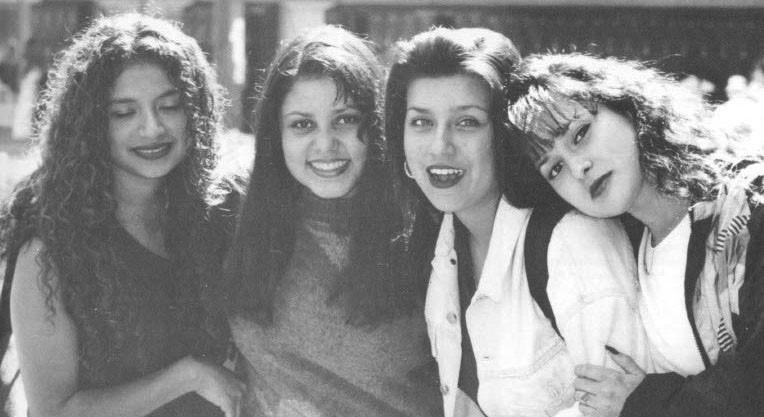
Students at Aragon in 1995.

When Aragon first opened in 1961, the student body consisted of 333 students, all of whom were sophomores. Now, 60 years later, more than 1700 students attend Aragon and the school has evolved and adapted in countless ways. With its growth, clubs, extracurriculars, academics and the overall culture of Aragon have all changed.
Diane McClain, an Aragon alumna, transferred to Aragon from San Mateo High School as a sophomore to join Aragon’s first ever class: the class of 1963. The student body consisted of students from San Mateo High School and Hillsdale High School, but because there hadn’t been a previous class at Aragon, the school didn’t have a clear-cut culture.
“I don’t remember there being … jealousy or bullying or anger at each other,” McClain said. “[By the end of high school] we were kind of proud of ourselves. We took something that was nothing and we created a high school and not many people get that opportunity.”
Even in terms of academics, which Aragon is now well-known for, students didn’t feel at odds with one another.
“We were all the same [in terms of academics],” McClain said. “I don’t remember if there were AP classes [at all].”
However, over time, academic competition has become deeply entrenched in Aragon’s culture. Jennifer Wei, an Aragon alumni who teaches AP English and ninth grade Guided Studies, has experienced this firsthand.
“We took something that was nothing and we created a high school”
“Even when I was in high school, it was very normal for someone to ask you, ‘What did you get on the essay [or] the test,’” Wei said. “It was normal for them to ask that before they even said hi to you, or asked how your day was. I see it less with my 9th graders and more with my 11th graders. What that tells me is that there’s something about the culture of the school that’s making that competition happen.”
Students are now also taking on heavier course loads.
“I know a lot of people that are taking … five [or] six AP classes,” said senior Claire Lautenbach.
Previously, students didn’t even have the option to take seven periods.
“When I was in high school, we had … a six period day,” Wei said. “[Now] there is a lot more of taking the class to perform and not taking the class to learn.”
However, some aspects of the school’s culture have improved.
“We were infamous for not having school spirit,” Wei said. “I think it’s cool that our school has gotten better at … supporting each other.”
Katherine Ward, an AP Biology and Biotechnology teacher, has taught at Aragon since she began teaching students in 1995. After being a part of Aragon’s teaching staff for 26 year, Ward has gotten to know the staff culture inside out.
“I have always felt that as a staff … we really work to make sure that … what we invest our time and our effort … in is making our … school and our environment as student-centered, as safe and as … powerful [a] learning experience as it can be,” Ward said.
For students, this effort may translate differently throughout their careers at Aragon. Different subjects may resonate with different students, shaping varied experiences.
“You can find different teachers that … meet your teaching style in different classes throughout [high school],” Lautenbach said. “You’re always [going to] have some teachers that aren’t your favorite, but you just … work in the best way that you can with them.”
“There is a lot more of taking the class to perform and not taking the class to learn”
As for extracurriculars and clubs, both looked very different in 1961. While McClain wanted to participate in golf, Aragon did not have a team for girls and she was not allowed to play for the school’s boys team. Despite not being allowed to play golf, McClain did participate in other extracurriculars.
“I was a cheerleader for the rest of high school,” McClain said. “I loved it. We had lunchtime [rallies] when there [were] big games coming, but we had to … make up all the cheers. We had to do … the first [of] everything.”
During the school’s early days, the student body wasn’t nearly as diverse as it is today.
“We had maybe two Asian kids in our class and maybe one Black kid,” McClain said. “All of the Asian … and Black kids stayed at San Mateo High School because that’s where they lived. In those days, [people of color] could not live in Parkside and Shoreview.”
However, Aragon has experienced a rise in diversity over the years with 27.56% of the population being white, 25.9% Hispanic or Latinx, 22.24% Asian, 3.37% Filipino, 2.42% Pacific Islander, 0.41% Black, 0.12% American Indian or Alaskan Native and 17.98% of two or more races in the 2020-21 school year.
“A lot of teachers and staff members and administrators have worked really hard to make [Aragon] a better school,” Wei said. “The increased inclusivity is the [result of] hard work over many years. I don’t think there’s anything natural about that.”
Overall, Aragon’s changes have created both positive and negative impacts on students
and staff.
“The changes have been in the right direction,” Ward said. “I feel like students and staff are always looking at how [we can] make this place even better … [but] I think that there’s still room for change.”
Throughout the years, Aragon has grown to embody the culture and atmosphere associated with the school today.




